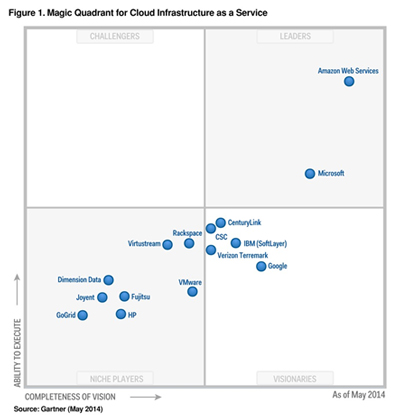Microsoft Azure Slowly Gaining on Amazon Web Services
While Amazon Web Services (AWS) remains by far the most widely used cloud provider by enterprises, it appears Microsoft's Azure cloud service has gained significant ground over the past year since releasing its Infrastructure as a Service (IaaS) offering.
Azure was the No. 2 cloud service behind Amazon last year, according to a Redmond magazine reader survey, and that finding remained consistent this year, as well. But given Redmond readers are predisposed to using Microsoft technology, it has always remained a mystery which cloud provider was the greatest alternative to Amazon in the broader IT universe.
Every major IT vendor -- including Google, IBM, Hewlett-Packard, Oracle and VMware -- and the telecommunication service providers offer enterprise public cloud services and want to expand their footprints. Many of them, notably Rackspace, AT&T, IBM and HP, are betting on OpenStack infrastructures, which, besides Amazon, is the most formidable alternative to Azure.
In the latest sign Azure is gaining ground, Gartner last week released its Magic Quadrant for IaaS providers, where only Amazon and Microsoft made the cut as leaders (a first for Microsoft in that category). Gartner published a measured assessment of Azure IaaS and all of the major cloud service providers.

"Microsoft has a vision of infrastructure and platform services that are not only leading stand-alone offerings, but that also seamlessly extend and interoperate with on-premises Microsoft infrastructure (rooted in Hyper-V, Windows Server, Active Directory and System Center) and applications, as well as Microsoft's SaaS offerings," according to Gartner's report.
"Its vision is global, and it is aggressively expanding into multiple international markets. It is second in terms of cloud IaaS market share -- albeit a distant second -- but far ahead of its smaller competitors. Microsoft has pledged to maintain AWS-comparable pricing for the general public, and Microsoft customers who sign a contract can receive their enterprise discount on the service, making it highly cost-competitive. Microsoft is also extending special pricing to Microsoft Developer Network (MSDN) subscribers."
The fact that Azure has a wide variety of features in its Platform as a Service (PaaS), as well, offers significant complementary offerings. Microsoft also was one of two vendors described as leaders in Gartner's application PaaS (which it calls aPaaS) Magic Quadrant back in January, bested only by Salesforce.com, now a Microsoft partner.
"The IaaS and PaaS components within Microsoft Azure feel and operate like part of a unified whole, and Microsoft is making an effort to integrate them with Visual Studio, Team Foundation Server, Active Directory, System Center and PowerShell. Conversely, Windows Azure Pack offers an Azure-like user experience for on-premises infrastructure," according to Gartner. "Microsoft has built an attractive, modern, easy-to-use UI that will appeal to Windows administrators and developers. The integration with existing Microsoft tools is particularly attractive to customers who want hybrid cloud solutions."
That's a pretty glowing assessment of Azure, but Gartner also issued some warnings to customers considering Microsoft's cloud service. Notably, Gartner cautioned that Microsoft's infrastructure services are still relatively new -- just over a year old -- while Amazon has offered IaaS since 2006.
"Customers who intend to adopt Azure strategically and migrate applications over a period of two years or more (finishing in 2016 or later) can begin to deploy some workloads now, but those with a broad range of immediate enterprise needs are likely to encounter challenges," according to the Gartner report.
Gartner also warned that Microsoft faces the challenge of operating and managing its Azure at cloud scale and enabling enterprises to automate their infrastructures. In addition, Microsoft is still in the early stages of building out its partner ecosystem and doesn't yet offer a software licensing marketplace, it pointed out. Despite offering some Linux services, Gartner believes Azure is still "Microsoft-centric," appealing primarily to .NET developers. That's an image Microsoft has begun working in earnest to shake. For example Microsoft has open-sourced some of its own .NET offerings, while making Java a first-class citizen on Azure.
Microsoft has 12 datacenters worldwide supporting Azure and that number will reach at least 16 by year's end, the company said. Azure is a key component of Microsoft's hybrid cloud strategy, called Cloud OS, which is based on running multitenant instances using Windows Server, System Center, the Azure Pack (for running Azure-like operations in a private datacenter) and the public cloud.
Azure took center stage at last month's TechEd conference in Houston. It was evident in the keynote, but also in talking with folks on the show floor. "I'm seeing more rapid adoption of Azure overall," said Randy DeMeno, CommVault's chief technologist for Windows.
And speaking during a TechEd session, BlueStripe CTO Vic Nyman noted the benefits of using Azure to scale on demand. "Using Azure, and particularly Platform as a Service and Infrastructure as a Service, is a simple, elegant solution whose presentation layers, turning up and down, is an interesting trend we see."
Are you looking at Azure to scale your infrastructure?
Posted by Jeffrey Schwartz on 06/02/2014